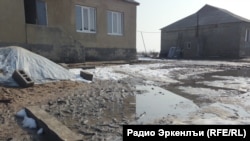Sixty-three years after Soviet dictator Josef Stalin's death, the impact of his World War II-era deportations of entire ethnic groups is still evident in the North Caucasus.
Among the estimated 497,478 Chechens deported by the Soviet leader to Central Asia in February 1944 were 3,142 Chechen families from the Aukh district of Daghestan that bordered on the then-Checheno-Ingush Autonomous Soviet Socialist Republic. Some 5,800 Laks from Daghestan's southern mountainous Kuli district were then forcibly resettled in the Chechens' abandoned homes, and Aukh was renamed the Novolak district.
In 1991, the third Congress of Peoples of Daghestan formally approved the Chechens' return to their homes. The following year, the Russian government duly adopted a program to resettle some 13,000 Laks from nine villages in Novolak district where they had lived for almost half a century.
It took years, however, before that process got under way, due to the need to build alternative accommodation for the Laks who had been resettled in Novolak. As of late 2008, only some 2,500 of them had vacated their homes. Most of the remainder are reluctant to move because the substitute housing offered in the new development of Novostroi on swampy lowland on the coast of the Caspian Sea north of Makhachkala is in many cases unfit for human habitation, employment prospects are nil, and some of the land plots promised to the resettlers have reportedly been illegally sold for commercial development.
Daghestani Deputy Prime Minister Rayuddin Yusufov, himself a Lak (the Laks are the fifth largest of Daghestan's 14 titular ethnic groups), pledged in March 2015 that the resettlement process would be completed by the end of 2018. At that time, the Chechens had taken possession of only 352 of the 2,207 dwellings in Novolak to which they were reportedly entitled.
Impatient at the repeated delays, however, the Chechens are apparently not willing to wait that long: the news agency Regnum reported two months ago that they had appealed to Russian President Vladimir Putin and Republic of Daghestan head Ramazan Abdulatipov to expedite their return, after which Novolak is to formally revert to its old name of Aukh district.
Possibly in response to that appeal, the Daghestani authorities are now threatening those Lak families who have not yet left the Novolak district that they will forfeit the right to new accommodation in Novostroi unless they vacate their present homes. At least 1,000 of the total 3,000-plus homes built in Novostroi remain empty; others are rented out while their Lak owners remain in Novolak. Meanwhile, funding for the resettlement process has been suspended.
Moreover, in addition to the repossession of their homes in Novolak and the restoration of the name Aukh district, the Chechens are now also demanding the simultaneous revision of the southern borders of the current Novolak district to incorporate into the reconstituted Aukh district two villages, Leninaul and Kalininaul, that were part of it prior to the 1944 deportation, but were subsequently included in the neighboring Kazbekov district. The population of those two villages are predominantly (65 percent) Avars, and vehemently oppose the Chechens' demands.
The Daghestani authorities have nonetheless reportedly consented to redraw the border between the two districts, but only after the departure from the Novolak district of the Laks (who in 2010 accounted for 14,000 of its total 33,000 population, compared with 8,000 Chechens and 6,000 Avars) and the restoration of the name Aukh district.
How that is to be accomplished is questionable, however. Former Leninaul village head Sira Saipov points out that any change to the borders of a municipality must be put to a referendum, and the Kazbekov Avars would vote "unanimously" against. Saipov further recalled that the third Congress of Peoples of Daghestan, which he attended as a delegate, agreed only that Aukh district should have its original name restored, but not to any revision of municipal borders.
The campaign to expedite the renaming of the Novolak district and the inclusion in it of Leninaul and Kalininaul is being spearheaded by Buvaysar Saytiyev, a Chechen who is simultaneously an adviser to both Abdulatipov and Chechen Republic head Ramzan Kadyrov. Saytiyev was elected to the Russian State Duma in September as one of several members of the ruling United Russia party representing Daghestan.




